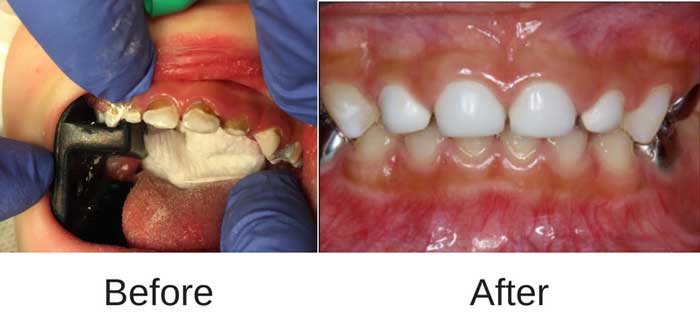How to Look for Baby Bottle Tooth Decay

Did you know that even 4-year-olds can develop baby bottle tooth decay? Several months ago, Dr. Hernandez helped a 4-year-old patient with severe baby bottle tooth decay regain healthy teeth and a happy smile. We were thrilled to see the patient helped, but we were also motivated to help more parents know how to prevent this.
Sometimes it’s easy to forget that, even though baby teeth are temporary, maintaining healthy baby teeth is an essential part of your child’s health. Untreated tooth decay in children and infants can lead to eating dysfunction, speech difficulties, or improper alignment of adult teeth. Baby bottle tooth decay, also known as early childhood caries or bottle mouth, is one of the most common childhood diseases. It occurs most frequently in children ages 2-5 years old, and the good news is that it’s usually preventable. How?
As a parent, there are many things that you can do to help prevent tooth decay or to identify it immediately and intervene with treatment. So what are you looking for, and how can you check your child’s mouth?
Know the signs of tooth decay: Small white spots on your baby’s teeth are typically the earliest symptom of tooth decay. Later possible symptoms include brown or black spots on the teeth, bleeding gums, fever, swelling, or irritability, and bad breath.
How to check for tooth decay: Checking your child’s mouth for tooth decay can be a challenge, though, since we all know that getting a baby to let you look inside its mouth is about as easy as saddling a rhinoceros. Here are some ideas:
- Observe your child’s teeth when you are cleaning his face after a meal.
- When you play with your kid and hold or tip him upside-down, try to peek inside his open mouth.
- Naptime is a great time to gently explore your child’s mouth! Especially if your baby falls asleep while you are holding him, you can probably lift his lip and take a good look without waking him up.
How to prevent tooth decay: Preventing decay is obviously the best strategy, so let’s talk about the best ways to prevent baby bottle tooth decay.
- Don’t put your baby to bed with a bottle of milk or juice. The sugars will collect around the teeth and create decay during the night. If your child absolutely has to have a bottle at night, water is the best option.
- Don’t share your spoon with your baby. The bacteria in your mouth can transfer to your child’s mouth and increase his risk of decay.
- Teach your kid to use a cup by the time they are 1. Cups don’t allow for sugars to pool around the teeth and attack it for extended periods of time.
- Wipe off gums and/or brush teeth after every feeding.
- Use fluoridated water. Fluoride strengthens the enamel and enables it to resist bacterial attack. In fact, it can even be used to repair minor cavities or soft spots in the enamel.
Being alert to the causes and symptoms of baby bottle tooth decay can make all the difference for your child’s oral health! Let us know your questions, and we’ll be glad to help you make sure your kiddos stay healthy and happy.
